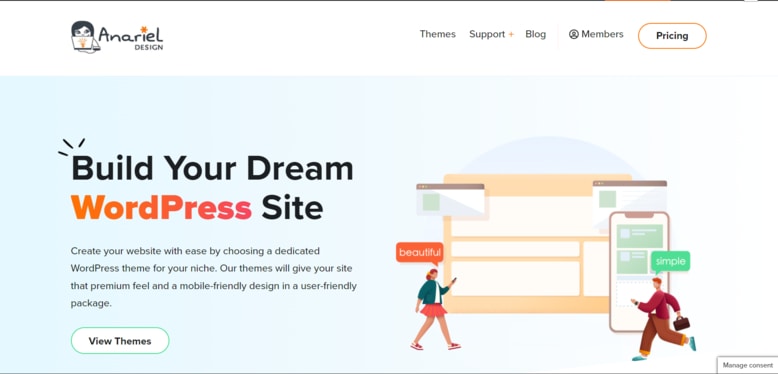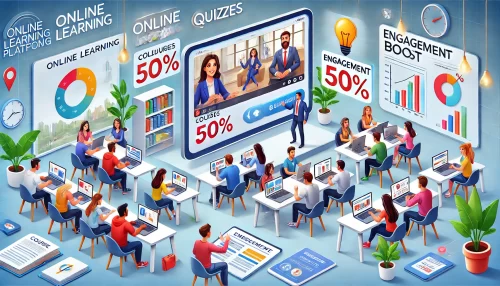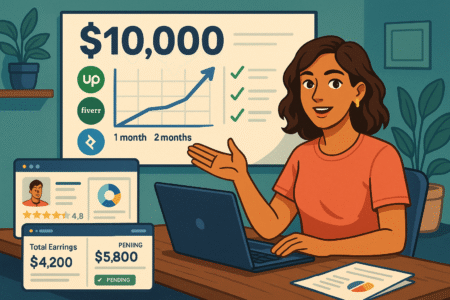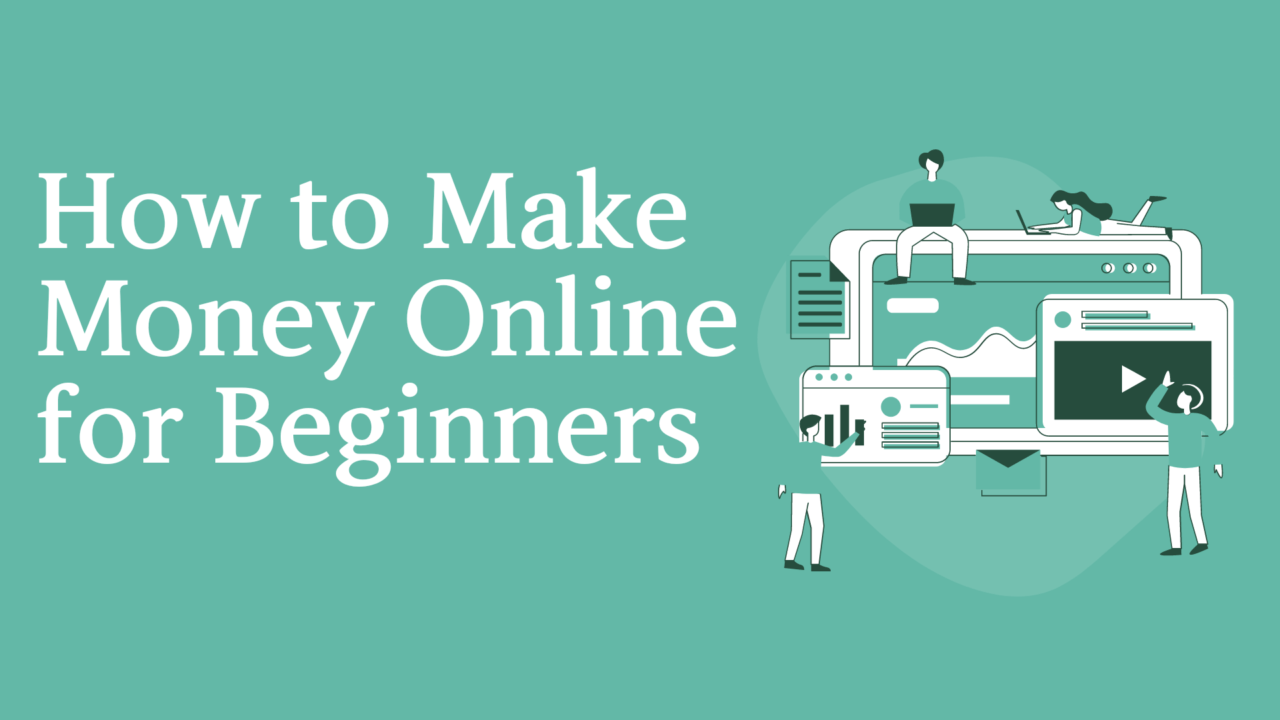How to freelance graphic design? Are you contemplating a foray into freelance graphic design? Do you wonder if you have what it takes to succeed in this competitive yet rewarding field?
Graphic design is not just about possessing creativity and skill; it’s about turning those assets into a thriving freelance career. This section aims to answer these questions and more, offering a roadmap to embarking on your freelance journey.
If you ask me, the key to a successful freelance career lies in leveraging your unique strengths, continuously expanding your skill set, and cultivating strong client relationships.
My recommendation for those considering this path is to approach it with an open mind, a willingness to adapt, and a readiness to embrace the challenges and rewards that come with freelancing. Here’s how you can start navigating the exciting world of freelance graphic design.
Table of Contents
Discover the Essentials of Freelance Graphic Design
Did you know that the freelance graphic design market is booming, with a projected growth rate that outpaces many traditional careers? This surge is driven by the ever-increasing demand for digital content and the flexibility that freelancing offers both designers and clients.
Understanding how to freelance graphic design is crucial in this evolving landscape. It’s about much more than just creativity; it’s about turning that creativity into a viable, flourishing career.
Firstly, it’s important to grasp the essentials of freelance graphic design. This encompasses not only the artistic aspect but also understanding market trends, client needs, and how to position yourself within the industry.
From my perspective, a successful freelance graphic designer is someone who not only produces exceptional work but also understands the dynamics of the freelance marketplace. They know how to navigate client relationships, set competitive rates, and manage projects efficiently.
Moreover, as we delve deeper into the essentials, we find that continuous learning and adaptation are key. The graphic design field is constantly evolving, with new tools and technologies emerging regularly.
In my opinion, staying updated with these advancements and incorporating them into your work is what sets you apart. Additionally, understanding your unique value proposition and effectively communicating it to potential clients can significantly impact your success in the freelance graphic design world.
Understanding the Freelance Market: A Starter Guide
Navigating the freelance market can initially seem overwhelming. According to recent studies, the freelance economy is thriving, with more businesses than ever turning to freelancers for their graphic design needs.
This trend opens up a myriad of opportunities for skilled designers. From my point of view, the key to understanding the freelance market lies in identifying your niche, knowing your target audience, and building a strong network.
Building a successful freelance career in graphic design also involves understanding the competitive landscape. I believe that by analyzing what successful freelancers are doing, you can identify gaps in the market that you can fill.
Moreover, engaging with the freelance community can provide invaluable insights and opportunities for collaboration and growth.
Finally, it’s crucial to stay informed about the latest industry trends and client preferences. In my estimation, this not only helps in attracting the right clients but also in positioning yourself as a go-to expert in your niche.
Leveraging social media and professional networking sites can also significantly enhance your visibility and attract potential clients.
Essential Tools and Software for Aspiring Freelancers
In the realm of freelance graphic design, having the right tools and software is non-negotiable. From advanced design software to project management tools, these resources play a pivotal role in the quality and efficiency of your work.
In my view, investing in the right software not only enhances your productivity but also elevates the quality of your designs, setting you apart from the competition.
For aspiring freelancers, Adobe Creative Suite remains the gold standard for design software, encompassing Photoshop, Illustrator, and InDesign. However, I recommend exploring other software like Sketch and Affinity Designer, which offer unique features and efficiencies.
Moreover, project management tools like Trello or Asana can streamline your workflow, allowing you to keep track of deadlines and communicate effectively with clients.
Most importantly, staying updated with the latest tools and technologies in the industry is crucial. I strongly believe that continuous learning and skill development are key to staying relevant and competitive in the freelance graphic design market.
Whether through online courses, webinars, or community workshops, enhancing your technical skills and software proficiency is essential for success.
Crafting Your Unique Brand as a Graphic Designer
“Your brand is the single most important investment you can make in your business” – Steve Forbes. In the world of freelance graphic design, this statement holds immeasurable truth.
Crafting a unique brand isn’t just about designing a logo or choosing a color palette; it’s about creating an identity that communicates your values, your style, and what sets you apart from the competition. Here’s how you can start building a brand that not only resonates with your target audience but also reflects your personal vision and creative ethos.
Creating a unique brand as a graphic designer involves deep introspection and market research. It’s crucial to understand not just who you are as a designer, but also who your ideal clients are. From my perspective, building a brand is akin to telling a story.
Your brand should communicate where you’ve come from, what you’re passionate about, and where you’re heading. This narrative not only helps potential clients understand your design philosophy but also builds a deeper connection with them.
Moreover, your brand should be reflected in every aspect of your business – from your website design to your social media presence, and even the way you communicate with clients. In my opinion, consistency is key. A cohesive brand experience can significantly enhance your credibility and professional image.
Additionally, I believe that your unique selling proposition (USP) should be evident in your branding. Whether it’s your innovative design approach, exceptional customer service, or niche expertise, highlighting what makes you different is crucial for standing out in a crowded market.
Building a Memorable Brand Identity
“A brand is a voice and a product is a souvenir” – Lisa Gansky. When it comes to building a memorable brand identity for a freelance graphic designer, this quote beautifully encapsulates the essence of what you should aim for.
Your brand identity is more than just visual elements; it’s the voice that speaks to your clients, the personality that permeates your work, and the experience you offer. Here’s how you can start crafting an identity that not only captivates but also endures.
First and foremost, I suggest focusing on the core elements of your brand identity: your logo, color scheme, typography, and imagery. These elements should not only reflect your personal style and the nature of your work but also be adaptable across various mediums.
From my point of view, a memorable brand identity is one that clients can recognize instantly, whether it’s on your business card or your social media profile.
Additionally, storytelling plays a crucial role in building your brand identity. In my experience, sharing the story behind your brand, your design journey, and the values that drive your work can significantly enhance your brand’s appeal. It makes your brand relatable and builds an emotional connection with your audience.
Moreover, engaging with your audience through consistent and meaningful content – be it blog posts, social media updates, or email newsletters – can reinforce your brand identity and keep your audience engaged.
Showcasing Your Style: Portfolio Tips That Attract Clients
“Design is thinking made visual” – Saul Bass. For freelance graphic designers, showcasing your style through your portfolio is crucial in attracting the right clients. Your portfolio is not just a collection of your work; it’s a testament to your skills, your design philosophy, and your ability to meet client needs.
Here are some tips on how to make your portfolio stand out and attract clients who appreciate your unique style.
Firstly, I recommend curating your portfolio with intention. Select projects that not only demonstrate your skills and versatility but also align with the type of work you want to attract. From my perspective, quality trumps quantity.
A well-curated portfolio that showcases your best work is more effective than a comprehensive portfolio that includes everything you’ve ever created.
Secondly, showcasing the process behind your designs can be incredibly powerful. Clients are often interested in understanding how you approach design challenges, your creative process, and the solutions you provide.
Including case studies or project stories in your portfolio adds depth to your work and demonstrates your problem-solving skills.
Lastly, ensure your portfolio is accessible and easy to navigate. In my opinion, a user-friendly portfolio that highlights your work effectively is essential.
Whether it’s through an online platform or a PDF, your portfolio should be designed with the viewer in mind, making it easy for potential clients to understand your capabilities and envision how your skills could benefit their projects.
Speaking personally, updating your portfolio regularly with new, relevant work can keep it fresh and reflect your growth as a designer.
Mastering the Art of Client Acquisition
Just as a well-oiled machine needs all its parts working in harmony to function at its peak, successful client acquisition in freelance graphic design requires a blend of strategy, skill, and consistency.
Mastering this art isn’t about a one-size-fits-all approach; it’s about understanding the nuances of marketing, communication, and relationship-building to attract and retain the clients who will not only appreciate your work but also contribute to your growth as a designer.
The foundation of effective client acquisition lies in a clear understanding of your target market. It’s crucial to identify not just who your ideal clients are, but also where they spend their time, what challenges they face, and how your design solutions can meet their needs.
Building a strong online presence is another key aspect of client acquisition. In today’s digital age, your online portfolio, social media profiles, and professional website serve as your digital storefront.
In my opinion, these platforms should not only showcase your work but also communicate your brand identity and the unique value you offer. Furthermore, engaging content and active participation in online design communities can elevate your visibility and position you as a thought leader in your field.
Effective Strategies to Attract Your Ideal Clientele
Attracting your ideal clientele is akin to fishing in the right pond with the right bait. You need to not only ensure you’re in the right market but also use strategies that appeal specifically to the clients you want to work with. To do this effectively, understanding your clients’ needs, preferences, and the challenges they face is paramount.
From my perspective, this knowledge allows you to craft targeted messages and solutions that resonate deeply with potential clients, thereby increasing the likelihood of conversion.
Content marketing stands out as a powerful tool in attracting ideal clients. By creating valuable, relevant content that addresses the specific needs and interests of your target audience, you can establish trust and position yourself as an authority in your niche.
In my estimation, blogs, case studies, and instructional videos not only showcase your expertise but also provide a platform for engaging with your audience on a deeper level.
Moreover, testimonials and case studies from satisfied clients can be incredibly persuasive to potential clients. I strongly believe in the power of social proof; it provides tangible evidence of your capabilities and the positive experiences previous clients have had with your services.
Showcasing these on your website and in your marketing materials can significantly enhance your credibility and attract clients who are looking for proven expertise.
Networking Mastery: Making Connections That Pay Off
Networking, both online and offline, is a critical component of client acquisition. It’s not just about attending events or joining online forums; it’s about building genuine relationships with potential clients, peers, and industry influencers.
In my experience, the most fruitful networking efforts are those that focus on offering value and support to others rather than just promoting one’s own services. This approach not only helps in building strong professional relationships but also increases the likelihood of referrals and collaborations.
Online platforms like LinkedIn, design forums, and social media groups offer vast opportunities for networking. Engaging in these spaces by sharing insights, providing feedback, and participating in discussions can raise your profile within the design community.
From my point of view, consistency in your online engagement can transform casual connections into meaningful professional relationships.
Offline networking shouldn’t be overlooked either. Attending industry conferences, workshops, and local meetups can provide valuable opportunities to connect with potential clients and collaborators in person. I would say that the personal connection made through face-to-face interactions often leads to stronger and more fruitful professional relationships.
Remember, every person you meet could be a potential client or could introduce you to one. Hence, I recommend always being prepared to discuss your work and the solutions you offer in a concise and compelling manner.
Pricing Your Services: A Comprehensive Guide
How can freelance graphic designers effectively price their services to reflect their skills, experience, and the value they provide to clients? It’s a question that many face when stepping into the freelance world. Pricing not only affects your profitability but also how potential clients perceive the quality of your work.
In this comprehensive guide, we’ll explore strategies to help you set competitive rates and navigate negotiations confidently, ensuring you’re fairly compensated for your creativity and hard work.
When it comes to pricing your freelance graphic design services, understanding your market is crucial. You should research what others in your field are charging, but remember, your rates should also reflect your unique skill set, experience, and the complexity of the projects you undertake.
From my point of view, transparent pricing models can build trust with potential clients and reduce the likelihood of disputes.
Moreover, consider offering different pricing structures, such as hourly rates for smaller tasks and project-based fees for larger undertakings, to accommodate a variety of client needs.
Another key aspect is communicating the value you bring to a project. It’s not just about the hours you put in; it’s about the expertise and unique perspective you offer.
I recommend clearly outlining the benefits of your services in your proposals and discussions. This can help justify your rates and highlight the return on investment clients can expect.
Additionally, keep in mind that as you gain more experience and your portfolio grows, revisiting and potentially increasing your rates is both reasonable and necessary for your business growth.
Setting Competitive Rates That Reflect Your Skills
Setting rates that accurately reflect your skills and the quality of your work is essential for a sustainable freelance career. But how do you determine what those rates should be?
First, it’s important to conduct a thorough assessment of your skills, considering factors like your education, years of experience, and the complexity of your design work.
According to industry standards and benchmarks can provide a baseline, but from my perspective, your rates should also factor in your operational costs and the value you deliver to clients.
In my opinion, one effective strategy is to calculate your desired annual income and work backward to determine your hourly or project-based rates, taking into account the number of billable hours you can realistically work.
This approach ensures you’re not just covering your expenses but also earning a profit. Most importantly, be transparent with clients about how you’ve arrived at your rates. This openness can foster trust and set the stage for a positive working relationship.
Moreover, consider the psychological aspect of pricing. I believe that pricing your services too low can undervalue your work and attract clients who may not value your expertise as they should.
Conversely, premium pricing, accompanied by a strong portfolio and client testimonials, can position you as a high-quality service provider. Remember, it’s about finding the right balance that reflects your skill level and allows you to attract the type of clients you want to work with.
Navigating Negotiations: Tips for Getting Your Worth
Negotiations are a natural part of the freelance business, but they don’t have to be a daunting experience. How do you ensure you’re getting your worth while remaining flexible to client budgets?
First, I suggest entering negotiations with a clear understanding of your minimum acceptable rate. This knowledge gives you a solid foundation to negotiate effectively and ensures you don’t agree to terms that undervalue your work.
It’s also important to listen to your clients’ needs and concerns during negotiations. I believe that negotiations are not just about reaching an agreement on price but about finding mutually beneficial solutions.
Offering package deals or slightly adjusting project scopes can often meet both your financial needs and those of your clients. From my perspective, being open to compromise, without underselling your value, is key to successful negotiations.
Lastly, don’t be afraid to walk away from projects that don’t meet your minimum requirements. While it can be challenging, especially when starting out, I strongly believe that valuing your work and time sets a precedent for future engagements. It signals to potential clients that you’re a professional who delivers quality work.
Remember, the right clients will see the value in your services and be willing to pay accordingly. Here’s how you can start setting yourself up for successful negotiations: be prepared, be confident, and be willing to find creative solutions that work for both parties.
Streamlining Your Freelance Workflow for Success
While it’s true that freelancing offers unparalleled flexibility and autonomy, it also comes with its own set of challenges, particularly when it comes to managing your workflow effectively. How to freelance graphic design successfully often hinges on your ability to streamline processes, manage time efficiently, and leverage technology to your advantage.
These elements are crucial not only for maintaining a high level of productivity but also for ensuring the quality of your work and your overall well-being as a freelancer.
The first step to streamlining your workflow is to establish a clear and organized structure for your projects. This involves setting realistic deadlines, prioritizing tasks based on urgency and importance, and breaking larger projects into manageable chunks.
From my point of view, having a visual representation of your workflow, such as a project timeline or a Kanban board, can significantly enhance your ability to stay on track and adjust as necessary. Most importantly, this structured approach can help reduce the stress and overwhelm that often accompany tight deadlines and demanding projects.
Additionally, setting aside specific times for checking emails and handling administrative tasks can prevent these necessary activities from interrupting your creative flow. I recommend batching similar tasks together to minimize context switching, a common productivity killer.
Moreover, regular reviews of your workflow and processes can reveal inefficiencies and opportunities for optimization, ensuring that you’re always working in the most effective manner possible.
Time Management Tricks for the Busy Freelancer
Effective time management is arguably the most critical skill for any freelancer. In a profession where deadlines are tight and clients’ needs can change rapidly, mastering the art of managing your time can make the difference between success and burnout. So, what to do to keep your schedule under control while ensuring high-quality output?
Firstly, I suggest starting each day with a clear plan. Identify your top priorities and allocate specific blocks of time to focus on these tasks. This technique, known as time blocking, can help you stay focused and make significant progress on important projects.
Another useful strategy is the Pomodoro Technique, which involves working for focused intervals (typically 25 minutes) followed by short breaks. This method can boost your productivity by encouraging deep focus and preventing fatigue.
From my perspective, the key is to find a rhythm that works for you and helps you maintain a steady pace throughout the day.
Additionally, learning to say no to projects that don’t fit into your schedule or align with your goals is crucial for managing your time effectively. In my experience, overcommitting is a common pitfall that can lead to missed deadlines and compromised quality of work.
Lastly, consider outsourcing or delegating tasks that fall outside your core competencies or consume an inordinate amount of time. Whether it’s administrative duties, accounting, or marketing efforts, freeing up more time to focus on your design work can enhance your productivity and the quality of your output.
In my estimation, investing in virtual assistance or collaborative partnerships can pay dividends in terms of both time saved and increased capacity for higher-value projects.
Leveraging Technology to Enhance Productivity
In the digital age, technology offers a plethora of tools and applications designed to streamline workflows, automate repetitive tasks, and enhance productivity. For freelance graphic designers, leveraging the right technology can transform the way you work, enabling you to accomplish more in less time and with less effort.
For instance, project management tools like Asana or Trello can help you keep track of your projects, deadlines, and communication with clients, all in one place. From my point of view, integrating these tools into your daily routine can significantly reduce the mental load of juggling multiple projects and deadlines.
Furthermore, utilizing cloud-based storage and collaboration tools such as Google Drive or Dropbox ensures that your files are organized, secure, and accessible from anywhere. This flexibility is particularly valuable for freelancers who may work from different locations or need to share large files with clients or collaborators.
Additionally, automation tools can handle time-consuming tasks such as invoicing, scheduling, and even social media management, freeing up more of your time to focus on creative work.
Most importantly, staying abreast of new technologies and continually assessing the tools in your arsenal are key to maximizing productivity. I strongly believe that being open to adopting new technologies that align with your work style and needs can provide a competitive edge in the fast-paced world of freelance graphic design.
Remember, the goal is not just to work harder but to work smarter, and technology is a critical ally in achieving that goal.
Expanding Your Skills: Growth Strategies in Graphic Design
Just as a tree must expand its roots to support its growth upwards, a freelance graphic designer must continuously broaden their skill set to elevate their career. In the ever-evolving field of graphic design, staying static is akin to falling behind.
Expanding your skills and adopting growth strategies are imperative to not only thrive but to also remain competitive and relevant in the marketplace. Here’s how you can start implementing growth strategies that foster both personal and professional development.
The first strategy involves actively seeking out new learning opportunities. The graphic design landscape is constantly changing, with new technologies, trends, and tools emerging regularly.
Keeping abreast of these changes and integrating them into your work can significantly enhance your offerings and appeal to clients. From my perspective, this could mean taking online courses, attending workshops, or even learning through project-based experiences.
Networking with other professionals in the field can also provide valuable learning opportunities and insights into emerging trends and technologies. I recommend joining design communities, both online and offline, as they can be a great source of support, inspiration, and collaboration.
Lastly, it’s important to apply what you learn in real-world projects. Experimentation is key to internalizing new skills and techniques. Whether it’s personal projects that allow you to explore new styles and technologies or incorporating new methods into client work, practical application is essential.
Staying Ahead: Continuous Learning and Skill Development
In the realm of graphic design, stagnation is the enemy of success. Staying ahead in this competitive field requires a commitment to continuous learning and skill development. But what does this look like in practice?
Firstly, it involves identifying areas for improvement or expansion in your skill set. Whether it’s mastering a new design software, exploring a burgeoning design trend, or enhancing your understanding of user experience principles, setting specific learning goals is crucial.
I strongly believe in the power of online learning platforms such as LinkedIn Learning, Coursera, and Udemy. These platforms offer a plethora of courses tailored to various aspects of graphic design and beyond.
Furthermore, attending industry conferences and webinars can also be incredibly enriching, providing insights into the future of the industry and opportunities to learn from leading experts.
Moreover, setting aside regular time for skill development is essential. It can be all too easy to get caught up in client work and neglect your professional growth.
I recommend scheduling weekly or even daily slots dedicated to learning and experimentation. This habit ensures that skill development becomes a natural part of your routine, rather than an afterthought.
Diversifying Your Offerings to Stay Relevant
As the saying goes, variety is the spice of life, and this certainly applies to the services offered by a freelance graphic designer. Diversifying your offerings not only makes your business more resilient to market changes but also opens up new avenues for creativity and income.
But where to start? Identifying complementary skills or services that align with your existing expertise and the needs of your target market is key. For instance, if you specialize in logo design, expanding into branding and identity services could offer a natural progression.
I also suggest exploring new niches or industries that are growing or underserved. This could involve adapting your skills to cater to sectors such as digital marketing, UI/UX design, or even animation. The key here is to research and understand the specific needs and challenges of these industries, allowing you to tailor your offerings accordingly.
Furthermore, collaboration with other professionals can offer a path to diversification. Partnering with copywriters, marketers, or web developers, for example, can enable you to offer comprehensive packages that cover a broader spectrum of client needs.
From my point of view, these collaborations not only broaden your service offerings but also provide valuable learning opportunities and access to new client networks.
Building a Sustained Freelance Career: Long-Term Strategies
“Success is not the key to happiness. Happiness is the key to success. If you love what you are doing, you will be successful.” – Albert Schweitzer. This poignant statement echoes loudly in the realm of freelance graphic design, where passion, perseverance, and strategic planning intertwine to shape a sustainable career.
Building a sustained freelance career requires more than just talent and hard work; it demands foresight, financial savvy, and the ability to cultivate lasting relationships with clients. Let’s explore the long-term strategies that can help you build a fulfilling and prosperous freelance career.
The cornerstone of a sustained freelance career is adaptability. The freelance market is dynamic, with trends, technologies, and client expectations constantly evolving. Staying adaptable means continuously updating your skills, diversifying your service offerings, and being open to new methods of working.
From my perspective, adaptability not only ensures your relevance in the market but also opens up new opportunities for growth and collaboration. Moreover, it encourages a mindset of lifelong learning, which is invaluable in the ever-changing field of graphic design.
Another vital strategy is the development of a strong personal brand. Your brand is what sets you apart in a crowded marketplace and communicates your unique value proposition to potential clients. I believe that a well-crafted personal brand can attract the right clients—those who appreciate your work and are willing to pay for quality.
Investing time and resources into building your brand, through a professional website, social media presence, and networking, is crucial. This effort pays dividends in establishing your reputation and attracting opportunities that align with your career goals and values.
Creating a Financial Plan for Stability and Growth
“Financial freedom is available to those who learn about it and work for it.” – Robert Kiyosaki. In the context of freelancing, creating a financial plan is not just about managing your current income and expenses; it’s about laying the groundwork for future stability and growth.
The first step is to understand your financial flow—tracking your income, identifying regular expenses, and pinpointing areas where you can cut costs or increase efficiency. From my point of view, this clarity is foundational for making informed decisions about pricing, savings, and investments.
I recommend establishing an emergency fund as one of your top priorities. This fund acts as a financial buffer during slow periods or unexpected expenses, ensuring that you can maintain your standard of living and keep your business running smoothly.
Moreover, considering retirement and health insurance plans is crucial for long-term financial security. Freelancers often need to navigate these aspects independently, and early planning can make a significant difference in your future well-being.
Investing in tools, software, and education that enhance your productivity and the quality of your work is also a smart financial decision. These investments not only improve your service offering but can also allow you to command higher rates.
From my perspective, allocating a portion of your income to professional development is an investment in your business’s future. Additionally, exploring passive income streams, such as selling digital products or online courses, can diversify your income and contribute to financial stability.
Cultivating Client Relationships for Repeat Business
“The goal as a company is to have customer service that is not just the best but legendary.” – Sam Walton. In the freelance world, cultivating strong client relationships is the key to generating repeat business and referrals, which are essential for long-term success.
Understanding your clients’ needs, exceeding their expectations, and maintaining open lines of communication are foundational elements of strong client relationships. In my experience, clients who feel valued and understood are more likely to return and recommend your services to others.
Personalization goes a long way in client relations. Remembering details about your clients’ preferences, business goals, and even personal milestones can make them feel special and foster loyalty.
I suggest sending personalized messages or small tokens of appreciation for continued business or referrals. This personal touch can differentiate you from competitors and deepen client relationships.
Moreover, seeking feedback is a powerful tool for improving your services and strengthening client relationships. Constructive feedback can provide insights into your clients’ perspectives, allowing you to refine your approach and deliver even greater value.
I recommend establishing a feedback loop where clients can share their experiences and suggestions. This not only demonstrates your commitment to excellence but also engages clients in a collaborative process, enhancing their investment in your relationship.
From my perspective, cultivating client relationships with care and intention is one of the most rewarding and impactful strategies for building a sustained freelance career.
Conclusion: Embrace Your Freelance Journey: Transform Your Passion into Profit
Surprisingly, many budding freelancers overlook the most critical aspect of their journey: the profound satisfaction derived from turning a passion into a successful career.
It’s not merely about financial gain; it’s about the freedom to choose projects that resonate with you, the flexibility to design your workday, and the joy of creating work that truly matters.
This concluding section encapsulates the essence of freelancing in graphic design, urging you to not only pursue this path with vigor but to also cherish the unique opportunities it presents.
Embarking on a freelance career in graphic design requires courage, resilience, and an unwavering commitment to growth and excellence. It’s a path fraught with challenges, yet it offers unparalleled rewards for those willing to navigate its complexities.
From my point of view, the keys to success lie in continuously honing your skills, building meaningful client relationships, and staying adaptable in the face of industry changes.
These practices not only enhance your professional development but also contribute to a fulfilling career that aligns with your personal goals and values.
Moreover, embracing the freelance journey means recognizing the importance of work-life balance. The flexibility of freelancing allows you to design a lifestyle that accommodates both your professional ambitions and personal well-being.
I strongly believe that finding this balance is crucial for sustaining your passion and creativity over the long term. Additionally, becoming part of a community of like-minded freelancers can provide support, inspiration, and opportunities for collaboration, enriching your freelance experience further.
In conclusion, transforming your passion for graphic design into a profitable freelance career is an achievable dream. It demands dedication, strategic planning, and a proactive approach to personal and professional development.
However, the satisfaction of building a career on your own terms, creating work you’re proud of, and making a meaningful impact through your designs is incomparable.
If you ask me, the journey of freelance graphic design is not just about the destination; it’s about the growth, discoveries, and connections you make along the way. Embrace this journey with an open heart and mind, and you may find that it leads you to more than just success—it leads to a rich and rewarding life.
frequently asked questions
What are the essential skills needed to start a freelance graphic design career?
To start a freelance graphic design career, essential skills include proficiency in design software like Adobe Creative Suite, understanding of design principles, strong communication abilities, and effective time management. Continual learning and adaptation to new tools and trends are also crucial for staying competitive in the market.
How can I build a strong portfolio as a freelance graphic designer?
Building a strong portfolio involves curating your best work to showcase your skills and style. Include a variety of projects that highlight your versatility, and consider adding case studies to explain your design process. Regularly update your portfolio with recent work and ensure it’s easily accessible online.
What strategies can help attract and retain clients in freelance graphic design?
Effective strategies to attract and retain clients include creating a professional online presence, leveraging social media for visibility, networking with industry peers, and delivering high-quality work consistently. Offering excellent customer service and asking for client testimonials can also boost your reputation and attract more clients.
How should I price my freelance graphic design services?
Pricing your services involves researching market rates, assessing your skill level, and calculating your business expenses. Consider setting both hourly rates and project-based fees. Communicate the value you provide clearly to clients and be prepared to negotiate to ensure you’re fairly compensated.
What tools and software are essential for freelance graphic designers?
Essential tools for freelance graphic designers include design software like Adobe Photoshop, Illustrator, and InDesign. Additionally, project management tools like Trello or Asana can help organize tasks and deadlines, while cloud storage solutions like Google Drive or Dropbox ensure easy access and file sharing.








